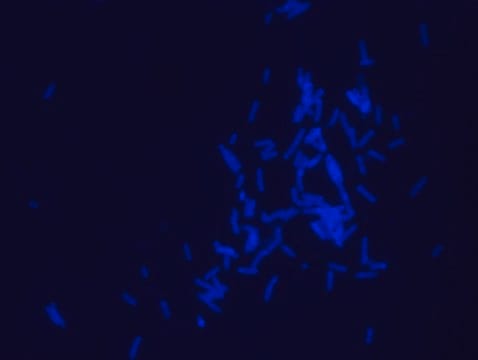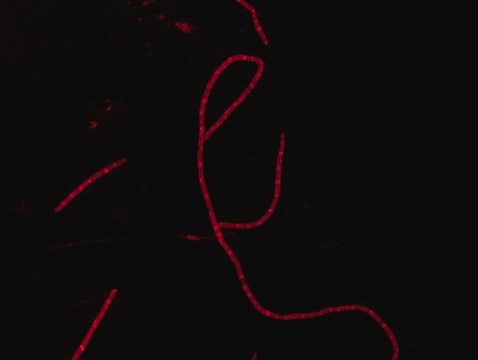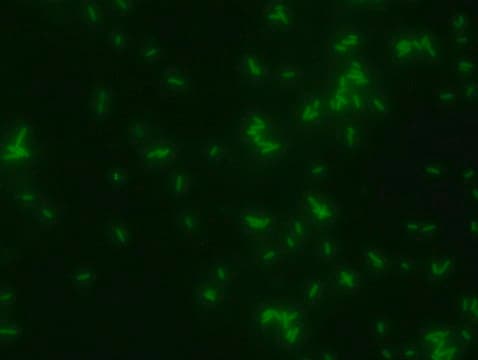推荐产品
品質等級
化驗
≥85% (HPLC)
形狀
solid
分子量
Mw 1840.66 g/mol
存貨情形
not available in China
儲存條件
protect from light
顏色
yellow to dark orange
適合性
suitable for (Fluorescent detection of gram-positive bacteria)
suitable for (Microbiome)
suitable for microbiology
抗生素活性譜
Gram-positive bacteria
作用方式
DNA synthesis
運輸包裝
dry ice
儲存溫度
−20°C
一般說明
FITC labeled Vancomycin (Vancomycin-FITC), is a Fluorescein conjugated Vancomycin, with a similar mode of action as Vancomycin. Vancomycin -FITC can be used to detect Gram-positive bacteria by common fluorescent instruments. Vancomycin is a glycopeptide antibiotic, used to treat gram-positive infections. Fluorescent antibiotics are obtained by synthetic conjugation of an antibiotic to a fluorophore.
應用
Fluorescent antibiotics can be used for many applications including:
- Antimicrobial resistance research.
- Bacterial visualization and imaging.
- Parent antibiotic mode of action research and new antibiotic discovery.
- Toxicity studies.
- Research of bacterial infections and tracking its uptake in vivo.
生化/生理作用
Vancomycin inhibits cell wall synthesis at the level of peptidoglycan biosynthesis. Vancomycin binds with high affinity and specificity to the terminal D-Ala-D-Ala of the growing peptide chain during cell wall synthesis. The binding inhibits transpeptidase activity, which prevents further elongation and cross-linking of the peptidoglycan matrix. Vancomycin-FITC has fluorescein attached to the amine group on the disaccharide moiety of the vancomycin molecule. This disaccharide moiety does not play any role in D-Ala-D-Ala binding site, affording a comparable binding affinity of Vancomycin-FITC to Gram-positive bacteria as the parent drug. However, a minimum inhibitory concentration (MIC) decrease of about two orders of magnitude in comparison to Vancomycin was observed. This activity decrease can be linked to repulsive interactions between the negatively charged Fluorescein moiety and the anionic environment of the peptidoglycan.
特點和優勢
- High-quality antibiotic suitable for multiple research applications
- Ideal for immunological, biochemical, and cell biology applications
- Suitable for fluorescent microscopy imaging
分析報告
- Aliquots of the DMSO solution can be stored at -20°C, protected from light for at least 1 month.
- Fluorescent microscopy application: Vancomycin -FITC has excitation/emission wavelength at 495 nm/515 nm.
- It is recommended to dissolve Vancomycin-FITC in DMSO (Dimethyl Sulfoxide) to a concentration of 1mg/mL.
- Recommended working concentration for Bacillus cereus in fluorescent microscopy imaging application is 25μg/mL.
其他說明
For additional information on our range of Biochemicals, please complete this form.
儲存類別代碼
12 - Non Combustible Liquids
水污染物質分類(WGK)
WGK 3
閃點(°F)
Not applicable
閃點(°C)
Not applicable
Choose from one of the most recent versions:
分析证书(COA)
Lot/Batch Number
Don't see the Right Version?
If you require a particular version, you can look up a specific certificate by the Lot or Batch number.
Analytical techniques for vancomycin−A review.
Sattur A P, et al.
Biotechnology and Bioprocess Engineering: BBE, 5, 153-158 (2000)
P J Loll et al.
Annual review of biophysics and biomolecular structure, 29, 265-289 (2000-08-15)
Vancomycin is the archetype among naturally occurring compounds known as glycopeptide antibiotics. Because it is a vital therapeutic agent used world-wide for the treatment of infections with gram-positive bacteria, emerging bacterial resistance to vancomycin is a major public health threat.
Richard A Daniel et al.
Cell, 113(6), 767-776 (2003-06-18)
Cell shape in most eubacteria is maintained by a tough external peptidoglycan cell wall. Recently, cell shape determining proteins of the MreB family were shown to form helical, actin-like cables in the cell. We used a fluorescent derivative of the
Pedro M Pereira et al.
Antimicrobial agents and chemotherapy, 51(10), 3627-3633 (2007-07-25)
A new method of fluorescence ratio imaging microscopy was used to compare the in vivo binding capacity and the access of a fluorescent derivative of vancomycin to the cell wall synthetic sites in isogenic pairs of vancomycin-susceptible and -resistant laboratory
Kittichoat Tiyanont et al.
Proceedings of the National Academy of Sciences of the United States of America, 103(29), 11033-11038 (2006-07-13)
The peptidoglycan (PG) layers surrounding bacterial cells play an important role in determining cell shape. The machinery controlling when and where new PG is made is not understood, but is proposed to involve interactions between bacterial actin homologs such as
我们的科学家团队拥有各种研究领域经验,包括生命科学、材料科学、化学合成、色谱、分析及许多其他领域.
联系技术服务部门






